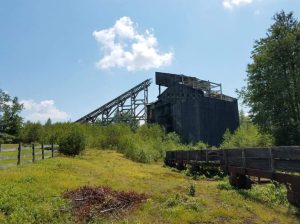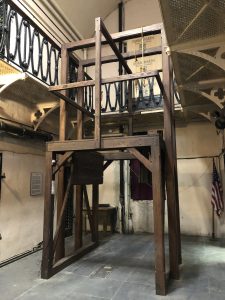The Tragedy of the Molly Maguires
Written by Cyan Fink, DLNHC Inventory Coordinator

Eckleys Miners’ Villiage Museum Coal Breaker built for the 1970 movie.
With St. Patrick’s Day right around the corner, we wanted to spend some time thinking about the many Irish immigrants who worked in an on our canals, railroads, and coal mines. One of the most notable groups of Irish immigrants were the Molly Maguires. You might have heard of them from the 1970 movie, The Molly Maguires, or when visiting Jim Thorpe, where the infamous jail is located.
Ireland and its people have a long history, steeped in centuries of Gaelic tradition. Unfortunately, their history also tells us a story of oppression. That oppression started under the English government with harsh landlord laws that caused many Irish to live in poverty. In response to their oppression, in the 1840s, groups such as the Molly Maguires were created to help ease the weight of oppression. These societies created rules on how members should conduct themselves with landlords. At the same time, many Irish immigrated to America during the Great Potato Famine. Unfortunately, the oppression at home followed the Irish across the seas to America. And some believe, so did their societies.
The anthracite coal region of Pennsylvania was a very popular area for the Irish coming to America. Most of the Irish were Catholics and therefore were often overlooked for jobs, but the coal region had an abundance of mining jobs which would hire them. The jobs, and their living situations, were difficult. Often times the companies they worked for would lease housing to the family and pay the men in company script which could only be spent in company-owned shops, making sure that the workers were forever indebted to the company. On top of that, wives feared for their men every day. Sometimes an unlucky family would have the body of their loved one dropped on their doorsteps to be buried.

A close-up image of a Pinkerton National Detective Agency Badge found at the National Canal Museum support center.
Agitation with the bosses started during the 1860s and reached a breaking point during the Panic of 1873 when workers and Unions were struggling to survive and bosses were living in luxury. In response to their oppression, during the 1870s letter started to be sent to the mine bosses threatening their lives if they did not change their ways. These letters were allegedly penned by the secret society, the Molly Maguires. The writers of those notes followed through with their threats and murders of the supervisors and bosses soon started. Franklin B. Gowen, president of the Philadelphia and Reading Railway and the Coal and Iron Company hired the Pinkerton Detective Service to go undercover and find the murderers. Allan Pinkerton sent James McParland, an Irishman himself, to investigate undercover as James McKenna.
McParland worked in the mines with these men for two years. He eventually came to believe members of the Workingmen’s Benevolent Association (WBA), a union, and the Ancient Order of Hibernians (AOH), a peaceful fraternal order for Irish Catholics, were actually Molly Maguires and were committing these murders.
At the same time, Gowen demanded a 20% pay cut for all miners. This caused the workers to strike and raised tensions between the two groups. Soon after, leaders of the WBA and AOH started to be assassinated. In 1875, a vicious attack took place when masked men entered a house and wounded two supposed Mollies and assassinated another and his wife. A few months later, more supposed Mollies were murdered and soon the miners were talking about revenge killings.

An image of the gallows constructed at the Old Jail in Jim Thorpe.
This was the opening McParland needed. At the end of his investigation he had accused 20 men of murder, arson, and kidnapping.
Of those 20 men, ten were hanged on June 21, 1877. Four men were prisoned and hanged in the Carbon County Jail were a scaffold was erected below the jail cells. One man, Alexander Campbell proclaimed his innocence as he watched the scaffold being built. It is said he rubbed his hand in the dirt of his cell floor and put his hand on the wall proclaiming, “That mark of mine will never be wiped out. It will remain forever to shame the County for hanging an innocent man.” The other 10 men were hanged the following year, including John “Black Jack” Kehoe, the so-called “King of the Mollies.”
Many historians and law experts now believe that the trials were unfair and the punishments barbaric as innocent men were most likely accused. It is even debated if the American Molly Maguires existed at all, as the only evidence was McParland’s testimony. In 1979, realizing their mistake, Pennsylvania granted John Kehoe a full pardon. Today, the Molly Maguires and the handprint are remembered in the Old Carbon County Jail, a hauntingly beautiful stone structure tucked away in the idyllic Jim Thorpe hillside. Educational tours run through the warmer months for people who are interested in catching a glimpse of the famous handprint that still rests on the jail cell’s wall.
**Brought to you by a project made possible in part by the Museums for America grant from the Institute of Museum and Library Services. The views, findings, conclusions, or recommendations expressed in this post do not necessarily represent those of the Institute of Museum and Library Services.**























Join the Conversation!